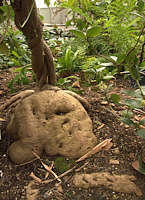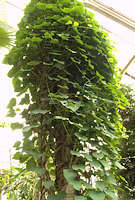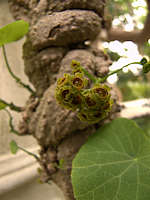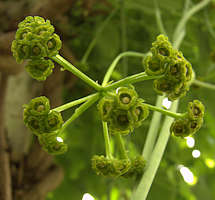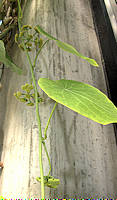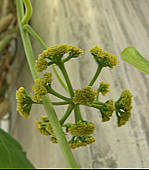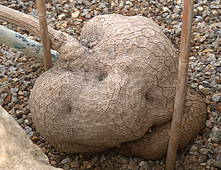Menispermaceae de Jussieu 1789
The Menispermaceae is a temperate to tropical family of around 70 genera and 450 species of dicotyledenous tropical flowering vines with twining stems and a few herbs, shrubs and trees. Leaves are alternate and simple, but may be palmately veined and often lobed. Floral parts of the unisexual flowers are in whorls of three. Male and female flowers are on separate plants, usually small and clustered in panicles or cymes. Fruits are drupes, the hard endocarp of which has features such as warts and ribs useful for identifying species.
Most species contain alkaloids which have similar effects to the paralysing hunting poisons curare, and berberine. Chondrodendron tomentosum (Curare Vine) is included in the Menispermaceae and is the source of the d-tubocurarine arrow poison. These alkaloids have medicinal value. Plants from the genera Stephania and Tinospora feature in Ayurvedic and Chinese medicine and despite their toxicity, are still used by herbalists.
The genus Stephania includes caudiciform succulent plants with vining top growths. Tinospora have succulent vining stems which sprout clusters of deciduous leaves or flowers at the appropriate season. Some species develop a succulent caudiciform base with age; others support themselves with aerial roots dropped from the branches e.g. Tinospora fragosa (Aaron's Rod).
|
Chasmanthera Hochstetter 1844
Greek: chasma = cleft plus Latin: anthera = anther
The genus Chasmanthera includes two similar species of lianes with succulent greyish-green stems, arising from a small caudex with peeling bark.
Native to tropical Africa.
|
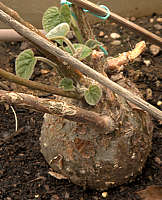 |
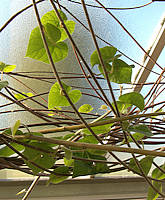 |
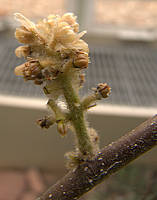 |
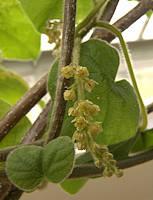 |
|
Above: Chasmanthera dependens Hochstetter 1844
This vining plant has long succulent greyish-green stems arising from a small caudex with peeling bark. The younger stems, cordate leaves and petiole are pubescent. The tiny, greenish male and brownish female flowers occur separately on long, hanging racemes originating in the leaf axils.
This plant is widely spread across tropical Africa including Angola, Congo, Eritrea, Ethiopia, Sierra Leone, Somalia, Tanzania, Uganda, Zambia and Zimbabwe. The stem, bark and roots contain several alkaloids with pharmacological activity. The plant is commonly cultivated for its traditional medicinal uses in the treatment of venereal disease and for anti-inflammatory and analgesic properties when applied topically to sprained joints and bruises.
Chasmanthera welwitschii Troupin 1951
is native to the Congo and is somewhat less hairy and with a longer inflorescence.
|
Above: Stephania glandulifera Miers 1871
The large surface tubers support woody, twining stems with heart shaped leaves. The flower clusters are on long stalks arising from leaf axils on both young and old woody stems. The orange-brown flowers are surrounded by green sepals.
This succulent plant is native to Burma. The powdered root or a decoction is used in North-East India and Nepal to treat stomach ache and as a topical anti-inflammatory agent for e.g. arthritis.
Photographed in the Temperate House, RBG Kew.
Right: Stephania rotunda de Loureiro 1790
This caudiciform succulent plant has a large tuber, with a cracked surface, supporting a long vine with light-green heart-shaped leaves. Clusters of tiny greenish-yellow flowers hang from leaf axils on long stems.
Native to Cambodia, Malaysia and South Vietnam. Traditionally used to treat malaria and fevers.
Photographed in the Augusta Princess of Wales Conservatory, RBG Kew.
|
|
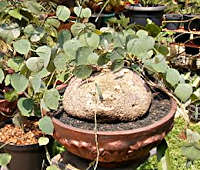 |
Stephania suberosa Forman 1980
The large surface tubers support woody perennial stems with heart-shaped leaves. The clusters of tiny flowers are greenish-yellow.
This succulent plant is native to dry tropical forests of Thailand.
Photo: Didi Turmudi
|








